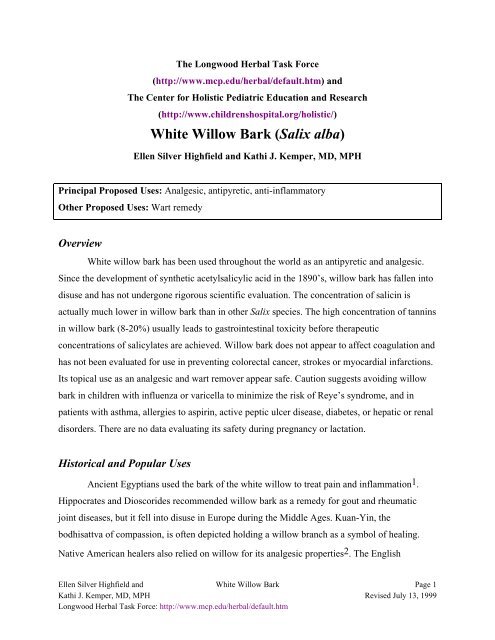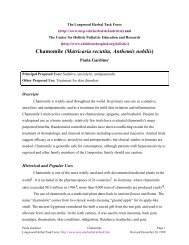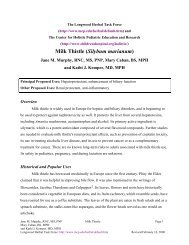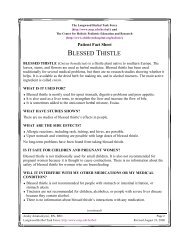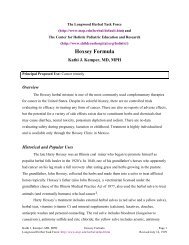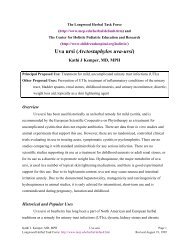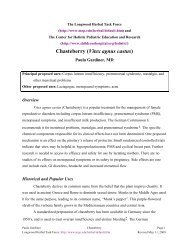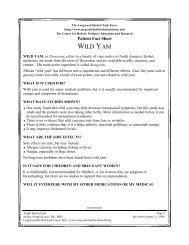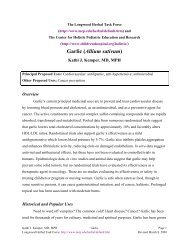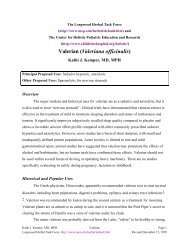White Willow Bark (Salix alba) - Longwood Herbal Task Force
White Willow Bark (Salix alba) - Longwood Herbal Task Force
White Willow Bark (Salix alba) - Longwood Herbal Task Force
You also want an ePaper? Increase the reach of your titles
YUMPU automatically turns print PDFs into web optimized ePapers that Google loves.
The <strong>Longwood</strong> <strong>Herbal</strong> <strong>Task</strong> <strong>Force</strong>(http://www.mcp.edu/herbal/default.htm) andThe Center for Holistic Pediatric Education and Research(http://www.childrenshospital.org/holistic/)<strong>White</strong> <strong>Willow</strong> <strong>Bark</strong> (<strong>Salix</strong> <strong>alba</strong>)Ellen Silver Highfield and Kathi J. Kemper, MD, MPHPrincipal Proposed Uses: Analgesic, antipyretic, anti-inflammatoryOther Proposed Uses: Wart remedyOverview<strong>White</strong> willow bark has been used throughout the world as an antipyretic and analgesic.Since the development of synthetic acetylsalicylic acid in the 1890’s, willow bark has fallen intodisuse and has not undergone rigorous scientific evaluation. The concentration of salicin isactually much lower in willow bark than in other <strong>Salix</strong> species. The high concentration of tanninsin willow bark (8-20%) usually leads to gastrointestinal toxicity before therapeuticconcentrations of salicylates are achieved. <strong>Willow</strong> bark does not appear to affect coagulation andhas not been evaluated for use in preventing colorectal cancer, strokes or myocardial infarctions.Its topical use as an analgesic and wart remover appear safe. Caution suggests avoiding willowbark in children with influenza or varicella to minimize the risk of Reye’s syndrome, and inpatients with asthma, allergies to aspirin, active peptic ulcer disease, diabetes, or hepatic or renaldisorders. There are no data evaluating its safety during pregnancy or lactation.Historical and Popular UsesAncient Egyptians used the bark of the white willow to treat pain and inflammation 1 .Hippocrates and Dioscorides recommended willow bark as a remedy for gout and rheumaticjoint diseases, but it fell into disuse in Europe during the Middle Ages. Kuan-Yin, thebodhisattva of compassion, is often depicted holding a willow branch as a symbol of healing.Native American healers also relied on willow for its analgesic properties 2 . The EnglishEllen Silver Highfield and <strong>White</strong> <strong>Willow</strong> <strong>Bark</strong> Page 1Kathi J. Kemper, MD, MPH Revised July 13, 1999<strong>Longwood</strong> <strong>Herbal</strong> <strong>Task</strong> <strong>Force</strong>: http://www.mcp.edu/herbal/default.htm
clergyman Edward Stone rediscovered the therapeutic value of willow bark in 1763 3 . <strong>Willow</strong>bark has been used to treat many different kinds of pain, including rheumatic pain, back pain,toothache, headache, and menstrual cramps. It is also used to relieve sore throat, fever andheadache associated with upper respiratory tract infections and influenza 4-6 .<strong>Willow</strong>’s active chemical constituent, salicin, was identified in 1829 by the Frenchpharmacist H. Leroux 3 . Salicylic acid was prepared in pure form by an Italian chemist in 1838.Salicylic acid was also extracted from wintergreen, spirea and other plants 3 . Salicin and salicylicacid were widely used by 19 th century European physicians to treat rheumatic fever and as anantipyretic, gout remedy and analgesic, particularly for joint pain 4 . However, the high dosesused (8-10 grams daily) routinely led to vomiting and gastric irritation, and the search was on fora less noxious salicylate.Acetylsalicylic acid was first synthesized by a French chemist in 1853 and wasrediscovered by Felix Hoffman at the Bayer Company in Germany who created acetylsalicylicacid from the spiric acid (spirin) found in meadowsweet in the 1890’s 7 . Bayer Aspirin quicklybecame one of the most popular drugs sold worldwide.Nowadays, synthetic acetylsalicylic acid is used not only as an analgesic and antipyretic,but to prevent myocardial infarctions, strokes and colorectal cancer. Some herbalists recommendwillow bark extract as a natural substitute for aspirin to achieve these same benefits. In Germany,willow bark is often taken along with aspirin to enhance the therapeutic effects while minimizingside effects 8 . The European Scientific Cooperative on Phytotherapy (ESCOP) has approvedwillow bark extract to treat fever, pain, and mild rheumatic complaints 9 .BotanyMedicinal species: <strong>Salix</strong> <strong>alba</strong> L (NOTE: There are over 300 <strong>Salix</strong> species called willow)Common names: <strong>White</strong> willow, catkins willow, European willow, salicin willow, withe withy;Weidenrinde, Fieberweidenrinde, Maiholzrinde (Ger); ecorce de saule (Fr)Botanical family: SalicaceaePlant description: <strong>Willow</strong> trees grow 6-18 meters high with supple branches. The male flowersare yellow and the female flowers are green. Catkins are cylindrical, approximately 6-7Ellen Silver Highfield and <strong>White</strong> <strong>Willow</strong> <strong>Bark</strong> Page 2Kathi J. Kemper, MD, MPH Revised July 13, 1999<strong>Longwood</strong> <strong>Herbal</strong> <strong>Task</strong> <strong>Force</strong>: http://www.mcp.edu/herbal/default.htm
cm long 10 . The outer surface of the bark can range in color from yellowish-green tobrownish-gray and from a smooth texture to faint longitudinal striations. The innersurface is smooth and white to pale yellow or cinnamon brown color 11 .Where it’s grown: <strong>White</strong> willow is native to Europe, Asia and North America. Like birch, it isvery cold hardy. <strong>White</strong> willow grows in a variety of climates from Maine to theAmazon 12 . The bark of young, two- to three-year-old branches is harvested during theearly spring 13 ; it is dried and prepared in liquid, cream, ointment, tablets and capsuleforms. Imports typically come from Bulgaria, Hungary, Romania and the formerYugoslavia 11 .Biochemistry<strong>White</strong> <strong>Willow</strong> <strong>Bark</strong>: Potentially Active Chemical Constituents11, 14• Glycosides (1.5-11%): salicylates (salicin, salicortin, populin, fragilin, tremulacin) 15, 16• Tannins (8-20%) 17• Aromatic aldehydes and acids: salidroside, vanillin, syringin, salicylic acid, caffeic andferulic acids• Salicyl alcohol (saligenin)• FlavonoidsSalicylates are found in a number of plants including other <strong>Salix</strong> species, wintergreen(Gaultheria procumbens), black cohosh root (Cimicifuga racemosa), poplar tree bark (Populusspp.) and sweet birch tree bark (Betula lenta). Other <strong>Salix</strong> species (e.g. S. nigra or black willow,S. daphnoides or violet willow, S. purpurea or purple osier, and S. fragilis or crack willow) arefrequently substituted for white willow in commercial products. Salicylate content appears to behighest in S. fragilis bark (1-10%), S. purpurea bark (3-9%), S. repens leaves (5-12%), and S.rosmaninifolia leaves (7-10%) and lowest in white willow bark (1.5-11%) 12, 14, 18, 19 . Theconcentration and availability of salicylates also varies within species according to growingconditions, processing and preparation 15, 20, 21 .Ellen Silver Highfield and <strong>White</strong> <strong>Willow</strong> <strong>Bark</strong> Page 3Kathi J. Kemper, MD, MPH Revised July 13, 1999<strong>Longwood</strong> <strong>Herbal</strong> <strong>Task</strong> <strong>Force</strong>: http://www.mcp.edu/herbal/default.htm
Salicin and salicortin are the primary salicylates found in white willow bark. They aremetabolized by intestinal flora to saligenin 22 , absorbed into the blood stream, and metabolizedby the liver to salicylic acid; excretion is primarily renal 11, 23 . More than 80% of salicin isabsorbed after oral administration 24 . Because of the time required to metabolize the willow’ssalicylates, the time to achieve therapeutic effects and the duration of effects are longer than withsynthetic salicylates 19, 25 .Salicylic acid is approved by the US Food and Drug Administration (FDA) as a topicaltreatment for warts and calluses. It is also included in many non-prescription medications to treatbunions and corns, and some over the counter acne remedies.Tannins are phenolic compounds found in many herbs and common foods such as sorreland rhubarb. Tannins are astringent and are traditionally used topically to treat wet or oozingskin conditions such as poison ivy and eczema. Tannins have also been used internally to treatdiarrhea and inflamed mucus membranes. Plants that contain more than 10% tannins havepotential adverse effects including upset stomach and nausea and vomiting acutely, and renaldamage, hepatic necrosis, and increased risk of esophageal and nasal cancer with long term use.<strong>Willow</strong> bark contains between 8-20% tannins, a higher concentration than in almost any otherplant. Tannins may interfere with the absorption of alkaloid compounds, salicylic acid, iodine,zinc, iron and copper. Drug-tannin precipitates may form in alkaline environments, interferingwith proper dosing 26 .Ellen Silver Highfield and <strong>White</strong> <strong>Willow</strong> <strong>Bark</strong> Page 4Kathi J. Kemper, MD, MPH Revised July 13, 1999<strong>Longwood</strong> <strong>Herbal</strong> <strong>Task</strong> <strong>Force</strong>: http://www.mcp.edu/herbal/default.htm
Experimental Studies<strong>White</strong> <strong>Willow</strong> <strong>Bark</strong>: Potential Clinical Uses1. Cardiovascular: none2. Pulmonary: none3. Renal and electrolyte balance: none4. Gastrointestinal/hepatic: none5. Neuro-psychiatric: Analgesic6. Endocrine: none7. Hematologic: Anticoagulant and antithrombotic8. Rheumatologic: Arthritis (See Immune modulation: Anti-inflammatory)9. Reproductive: none10. Immune modulation: Anti-inflammatory11. Antimicrobial: Antifungal12. Antineoplastic: Prevention of colorectal cancer13. Antioxidant: none14. Skin and mucus membranes: none15. Other/miscellaneous: Antipyretic; wart remedyWith the advent of synthetic aspirin, the use of willow bark fell by the wayside bothclinically and scientifically. Very few studies have addressed the physiologic effects of willowbark as opposed to aspirin. Modern herbalists have tended to extrapolate the data from studies onaspirin and apply those findings to willow bark. Studies cited refer to willow bark and/or salicin.1. Cardiovascular: none2. Pulmonary: none3. Renal and electrolyte balance: none4. Gastrointestinal/hepatic: none5. Neuro-psychiatric: Analgesic. Salicin does have analgesic properties. However, due to thelow concentration of salicin in willow bark, the amount extracted in typical preparations andthe metabolic transformation required to convert salicin and salicortin to salicylic acid,Ellen Silver Highfield and <strong>White</strong> <strong>Willow</strong> <strong>Bark</strong> Page 5Kathi J. Kemper, MD, MPH Revised July 13, 1999<strong>Longwood</strong> <strong>Herbal</strong> <strong>Task</strong> <strong>Force</strong>: http://www.mcp.edu/herbal/default.htm
achieving therapeutic effects would require approximately 35 grams of white willow barkthree times daily. At typical doses, willow bark is not expected to exert significant analgesiceffects 19 . However, recent unpublished data suggests that willow bark extracts may providesignificant therapeutic benefit even with low salicylate levels.i. In vitro data: noneii. Animal data: noneiii. Human data: In a randomized, double-blind placebo-controlled trial of 54 migrainesufferers, half were given a topical medicament containing salicin (dose unknown) andhalf were given a placebo. All were advised that when a headache began, they should liedown, apply the medicament to their forehead (amount unknown), cover the face with aphoto-occlusive mask and take their regular headache medications. Those treated withsalicin reported significantly more improvement than those assigned to placebotreatment 5 .6. Endocrine: none7. Hematologic: Anticoagulant and antithrombotic: Some herbalists recommend willow bark asa natural alternative to aspirin to prevent myocardial infarction and strokes. However,willow’s salicylates do not appear to interfere with coagulation.i. In vitro data: Unlike aspirin, sodium salicylate had no effect on platelet adhesion orplatelet release of ADP 27 .ii. Animal data: noneiii. Human data: Unlike aspirin, sodium salicylate did not prolong bleeding time in adults;nor did it inhibit platelet aggregation 27 .8. Rheumatologic: Arthritis (See Immune modulation: Anti-inflammatory)9. Reproductive: none10. Immune modulation: Anti-inflammatoryi. In vitro data: Unlike aspirin, salicin did not inhibit PHA-induced lymphocytetransformation 28 .ii. Animal data: noneiii. Human data: Although salicin does have anti-inflammatory properties, the concentrationin willow bark is so low that 25-35 liters of willow bark tea would be required to achieveEllen Silver Highfield and <strong>White</strong> <strong>Willow</strong> <strong>Bark</strong> Page 6Kathi J. Kemper, MD, MPH Revised July 13, 1999<strong>Longwood</strong> <strong>Herbal</strong> <strong>Task</strong> <strong>Force</strong>: http://www.mcp.edu/herbal/default.htm
dosages comparable to 4 grams of aspirin daily. However, a recent unpublished caseseries suggests that standardized willow bark extracts may provide significant therapeuticbenefit for patients with rheumatic pain. Randomized controlled trials are underway. Seethe report from the International Association for the Study of Pain:http://www.rzuser.uni-heidelberg.de/%7Ecn6/iasp-sig-rp/willow.html11. Antimicrobial: Antifungali. In vitro data: Aqueous extracts of dried willow bark displayed antifungal activity againstBotrytis cincerea and Penicillium digitatum, but were inactive against Aspergillusfumigatus, Aspergillus niger, Rhizopus nigricans, Trichophyton mentagrophytes andCandida albicans 29 .ii. Animal data: noneiii. Human data: none12. Antineoplastic: Prevention of colorectal cancer. No data on willow bark for this use.13. Antioxidant: none14. Skin and mucus membranes: none15. Other/miscellaneous: Antipyretic; wart remedya. Antipyretic: no recent scientific evaluationb. Wart remedyi. In vitro data: noneii. Animal data: noneiii. Human data: In central Italy dried willow bark is applied topically to treat warts 30 ; amodern home remedy is to tape a plain adult aspirin over a wart. There have been nocontrolled trials reported on willow bark’s use for this purpose, but it is likely to be aseffective as other home remedies.Ellen Silver Highfield and <strong>White</strong> <strong>Willow</strong> <strong>Bark</strong> Page 7Kathi J. Kemper, MD, MPH Revised July 13, 1999<strong>Longwood</strong> <strong>Herbal</strong> <strong>Task</strong> <strong>Force</strong>: http://www.mcp.edu/herbal/default.htm
Toxicity and ContraindicationsAll herbal products carry the potential for contamination with other herbal products, pesticides,herbicides, heavy metals and pharmaceuticals.Allergic reactions can occur to any natural product in sensitive persons.Allergic reactions to willow bark have been reported 26 . Persons known to be allergic to aspirinshould avoid herbal remedies containing willow bark.Potentially toxic compounds in willow bark: Salicin, salicortin, tanninsAcute toxicity: Toxicity is far less with willow bark than with aspirin due to the low levels ofsalicylates in the plant products. High doses can be associated with gastric and renalirritation, nausea, vomiting, and gastrointestinal bleeding, but side effects are far morelikely from the high tannin levels than the salicylates. There is one case report of awoman with glucose-6-phosphate dehydrogenase deficiency (G6PD) who developedmassive hemolysis after taking an herbal preparation containing salicin 31 .Chronic toxicity: None reported with willow bark, but theoretically possible due to salicylates.Limitations during other illnesses or in patients with specific organ dysfunction: Patients withtinnitus should avoid using herbal remedies such as willow bark that contain salicylates.Although side effects have not been reported, the salicylate content warrants cautious useby patients with allergies to aspirin, asthma, active peptic ulcer disease, diabetes, gout,hemophilia and other bleeding disorders, or hepatic or renal disease 32 .Interactions with other herbs or pharmaceuticals: None reported. There is a potential forinteraction with salicylate-containing medications and other non-steroidal antiinflammatorymedications (NSAIDs). There is not expected to be a negative interactionwith anticoagulant medications. Tannins may interfere with absorption of othermedications.Safety during pregnancy and/or childhood: Due to the potential of developing Reye’s syndromefrom salicylates, children with influenza or varicella should avoid willow bark. Safety hasnot been established for pregnancy and lactation. Salicylates in breast milk were reportedto cause a rash in one breast-fed baby 32 .Ellen Silver Highfield and <strong>White</strong> <strong>Willow</strong> <strong>Bark</strong> Page 8Kathi J. Kemper, MD, MPH Revised July 13, 1999<strong>Longwood</strong> <strong>Herbal</strong> <strong>Task</strong> <strong>Force</strong>: http://www.mcp.edu/herbal/default.htm
Typical DosagesProvision of dosage information does NOT constitute a recommendation or endorsement, butrather indicates the range of doses commonly used in herbal practice.Doses are given for single herb use and must be adjusted when using herbs in combinations.Doses may also vary according to the type and severity of the condition treated and individualpatient conditions.Plants containing salicylates have a very bitter taste, so willow bark tea may beunpalatable for most patients, particularly for children.A typical 500 mg dose of aspirin is equivalent to 794 mg of salicin. If extraction was100% effective, this amount of salicin could be derived from 80-150 grams of dried willowbark 33 . The usual dose of willow bark tea is typically 1-3 grams of bark per cup of water. Thus,the usual herbal products contain minute amounts of salicylates compared with aspirin.Tea is made by steeping ½-2 tsp. (1-3 grams) of the dried bark in 1 cup of boiling water for 10-20 minutes (infusion) or bringing this amount of cold water and dried bark to a boil for 5minutes (decoction) 11, 12 . Some herbalists suggest drinking one cup a day to helpprevent myocardial infarction and stroke. To treat fever and pain, 3-5 cups a day arerecommended (containing a total of 60-120 mg of salicin) 6 . Larger amounts are likely tolead to gastrointestinal upset due to the high tannin content of the bark.Tincture or glycerite: ½ tsp. three times daily 34Liquid extract (1:1 in 25% alcohol): 1-3 ml three times daily8, 35Capsules: Two to three 379 milligram capsules taken every 3-6 hours 8Topically: Infused in vegetable oil and rubbed over painful joints or muscles as needed 34Pediatric dosages: UnknownDosages used in herbal combinations: VariableEllen Silver Highfield and <strong>White</strong> <strong>Willow</strong> <strong>Bark</strong> Page 9Kathi J. Kemper, MD, MPH Revised July 13, 1999<strong>Longwood</strong> <strong>Herbal</strong> <strong>Task</strong> <strong>Force</strong>: http://www.mcp.edu/herbal/default.htm
See Also:<strong>Willow</strong> <strong>Bark</strong> Clinician Information Summary:http://www.mcp.edu/herbal/willowbark/willowbark.cis.pdf<strong>Willow</strong> <strong>Bark</strong> Patient Fact Sheet: http://www.mcp.edu/herbal/willowbark/willowbark.ph.pdfThe International Association for the Study of Pain:http://www.rzuser.uni-heidelberg.de/%7Ecn6/iasp-sig-rp/willow.htmlEllen Silver Highfield and <strong>White</strong> <strong>Willow</strong> <strong>Bark</strong> Page 10Kathi J. Kemper, MD, MPH Revised July 13, 1999<strong>Longwood</strong> <strong>Herbal</strong> <strong>Task</strong> <strong>Force</strong>: http://www.mcp.edu/herbal/default.htm
REFERENCES1. Vainio H, Morgan G. Aspirin for the second hundred years: new uses for an old drug. Pharmacology &Toxicology 1997; 81:151-2.2. Lewis WH. Medical botany : plants affecting man's health. New York: Wiley, 1977.3. Hedner T, Everts B. The early clinical history of salicylates in rheumatology and pain. ClinicalRheumatology 1998; 17:17-25.4. Friend D. Aspirin: the unique drug. Arch Surg 1974; 108:765-69.5. Hyson MI. Anticephalgic photoprotective premedicated mask. A report of a successful double-blindplacebo-controlled study of a new treatment for headaches with associated frontalis pain and photophobia.Headache 1998; 38:475-7.6. Schilcher H. Phytotherapy in paediatrics : handbook for physicians and pharmacists : with reference tocommission E monographs of the Federal Department of Health in Germany : includes 100 commission Emonographs and and 15 ESCOP monographs. Stuttgart: medpharm Scientific Publishers, 1997:181.7. Robbers JE, Speedie MK, Tyler VE. Pharmacognosy and pharmacobiotechnology. Baltimore: Williams &Wilkins, 1996:ix, 337.8. Peirce A. The American Pharmaceutical Association practical guide to natural medicines. New York:William Morrow and Company, Inc., 1999.9. Anonymous. Monographs on the medicinal uses of plants. Exeter: European Scientific Cooperative onPhytotherapy, 1997.10. Fleming T. PDR for herbal medicines. Montvale, NJ: Medical Economics Company, Inc., 1998.11. Bissett NG. <strong>Herbal</strong> drugs and phytopharmaceuticals. Stuttgart: MedPharm CRC Press, 1994:566.12. Duke JA. Green Pharmacy. Emmaus, PA: Rodale Press, 1997:507.13. Blumenthal M. The complete German Commission E monographs : therapeutic guide to herbal medicines.Austin: American Botanical Council, 1998.14. McGuffin M, Hobbs C, Upton R, Goldberg A. American <strong>Herbal</strong> Products Association's Botanical SafetyHandbook. Boca Raton. New York: CRC Press, 1997:231.15. Meier B, Lehmann D, Sticher O, Bettschart A. Identification and determination of 8 phenol glycosideseach in <strong>Salix</strong> purpurea and S. daphnoides by modern high pressure liquid chromatography. PharmaceuticaActa Helvetiae 1985; 60:269-75.16. Zaugg SE, Cefalo D, Walker EB. Capillary electrophoretic analysis of salicin in <strong>Salix</strong> spp. Journal ofChromatography 1997; 781:487-490.17. Thieme H. On the tannin content of willow cortex. Pharmazie 1968; 23:212.18. Meier B, Sticher O, Julkunen-Tiitto R. Pharmaceutical Aspects of the Use of <strong>Willow</strong>s in <strong>Herbal</strong> Remedies.Planta Medica 1988:559-60.19. Robbers JE, Tyler VE. Tyler's Herbs of choice : the therapeutic use of phytomedicinals. New York:Ellen Silver Highfield and <strong>White</strong> <strong>Willow</strong> <strong>Bark</strong> Page 11Kathi J. Kemper, MD, MPH Revised July 13, 1999<strong>Longwood</strong> <strong>Herbal</strong> <strong>Task</strong> <strong>Force</strong>: http://www.mcp.edu/herbal/default.htm
Haworth <strong>Herbal</strong> Press, 1999:x, 287.20. Meier B, Sticher O, Bettschart A. Quality control of willow bark: Quantitative analysis of total salicin inwillow bark and willow preparations with HPLC. Deutsche Apotheker Zeitung 1985; 125:341-47.21. Julkunen-Tiitto R, Gebhardt K. Further studies on the drying willow (<strong>Salix</strong>) twigs: The effect of low dryingtemperature on labile phenolics. Planta Medica 1992; 58:385-6.22. Julkunen-Tiitto R, Meier B. The enzymatic decomposition of salicin and its derivatives obtained fromSalicaceae species. Journal of Natural Products 1992; 55:1204-12.23. Fotsch G, Pfeifer S, Bartoszek M, Franke P, Hiller K. Biotransformation of phenolglycosides leiocarposideand salicin. Pharmazie 1989; 44:555-8.24. Steinegger E, Hovel H. Analytic and biologic studies on Salicaceae substances, expecially on salicin. II.Biological study. Pharmaceutica Acta Helvetiae 1972; 47:222-34.25. Chrubasik S, Eisenberg E. Treatment of rheumatic pain with herbal medicine in Europe. Pain Digest 1998;8:231-6.26. Brinker FJ. Herb contraindications and drug interactions : with appendices addressing specific conditionsand medicines. Sandy, Or.: Eclectic Institute, 1997:146.27. Weiss H, Aledort L, Kochwa S. The effect of salicylates on the hemostatic properties of platelets in man.Journal of Clinical Investigation 1968; 47:2169-80.28. Opelz G, Terasaki P. Suppression of lymphocyte transformation by aspirin. Lancet 1973; 2:478-80.29. Guerin J, Reveillere H. Antifungal activity of plant extracts used in therapy:1. Study of 41 plant extractsagainst 9 fungi species. Ann Pharm Fr 1984; 42:553-9.30. Leporatti M, Pavesi A. New or uncommon uses of several medicinal plants in some areas of central Italy. JEthnopharmacology 1990; 29:213-23.31. Baker S, Thomas PS. <strong>Herbal</strong> medicine precipitating massive haemolysis [letter]. Lancet 1987; 1:1039-40.32. Newall CA, Anderson LA, Phillipson JD. <strong>Herbal</strong> medicines : a guide for health-care professionals. London:Pharmaceutical Press, 1996:ix, 296.33. Schulz V, Hansel R, Tyler VE. Rational Phytotherapy: A Physicians' Guide to <strong>Herbal</strong> Medicine. Berlin:Springer, 1997:306.34. Bove M. An encyclopedia of natural healing for children & infants. New Canaan, CT: Keats Publishing,Inc., 1996.35. Weiss RF. <strong>Herbal</strong> medicine. Gothenburg, Sweden: AB Arcanum, 1988.Ellen Silver Highfield and <strong>White</strong> <strong>Willow</strong> <strong>Bark</strong> Page 12Kathi J. Kemper, MD, MPH Revised July 13, 1999<strong>Longwood</strong> <strong>Herbal</strong> <strong>Task</strong> <strong>Force</strong>: http://www.mcp.edu/herbal/default.htm


